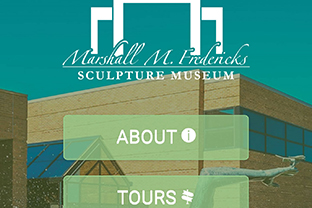June 25, 2018
SVSU students design new mobile app for Marshall M. Fredericks Sculpture Museum
 The Marshall M. Fredericks Sculpture Museum has launched a new app designed to allow visitors to tour the galleries and sculpture garden on their smartphones. The free app is available on both iOS and Android via the Apple App Store and Google Play Store. It can be downloaded in advance of a visit or in the gallery on the museum’s free Wi-Fi.
The Marshall M. Fredericks Sculpture Museum has launched a new app designed to allow visitors to tour the galleries and sculpture garden on their smartphones. The free app is available on both iOS and Android via the Apple App Store and Google Play Store. It can be downloaded in advance of a visit or in the gallery on the museum’s free Wi-Fi.The impetus for the project stems from the Marshall M. Fredericks Sculpture Museum’s current strategic plan which sets forth the goal to “Strengthen the use of technology in program.” To accomplish this aim, one of the strategies is to “offer memorable experiences – both on-site and online – through the best use of technology.”
Museum Director Marilyn Wheaton pointed out that museums across the country are developing apps as a means of giving every visitor the maximum benefit in looking at the collection and exhibitions.
“With an app, you can learn so much more about a work of art than if you rely on label text,” she said.
The app provides visitors with self-guided audio tours and more in-depth information about the museum, its collections, and temporary exhibitions in a fun, easy, and efficient manner. Upon opening the app, users are given four easy-to-navigate options – About, Tours, Support and Social – each of which helps users discover works of art, media and resources that best meet their interests. It can be found by searching for “MFSM.”
One of the highlights of the app is the ability to access detailed information, gleaned from the museum’s archives, for over 35 sculptures, opening visitors’ eyes to the museum’s collection like never before.
The new app was produced by the Museum in collaboration with Saginaw Valley State University’s art and computer science departments. Ka Vang, who recently graduated with a degree in graphic design, designed the app; she worked with Blake Johnson, SVSU professor of art and graphic design. Adam Pero, who recently graduated with a degree in computer science, completed all the coding. He worked with George Corser, SVSU assistant professor of computer science.
“The primary purpose of the project was to provide a real world educational experience for students, with collaboration between multiple departments within the university, to produce a real software product,” Corser said. “The overall project was a successful collaboration between SVSU's Art and Computer Science departments, the Museum, Information Technology Services, and University Communications.”
Vang, the student designer, learned a great deal through the project.
“It made me challenge the way I think, because I have to think like the user and how they might navigate through the app,” she said. “There was a lot of trial and error, a lot of testing, a lot of sketching. I learned a lot of tips and tricks. It’s a very competitive field and it really helps me to be able to say ‘I designed this.’ I can show it to people in an interview.”
That’s exactly what Pero, the computer science student, experienced.
“When I started working on the app, I didn’t have a job and I was struggling to get interviews. Afterward, I was able to show pieces of code during my interviews. That definitely helped me get my current job. It was a lot like being in class, but instead of being instructed, you figure it out on your own.”
Pero currently works as a software developer at Dice, a software and telecommunications company in Bay City. He also is a graduate student in SVSU’s master’s degree program in computer science and information systems.
Corser and Johnson are advisers for Cardinal Solutions, an interdisciplinary faculty/student team that works directly with local businesses and non-profits to develop marketing solutions.
“SVSU is such an amazing resource — skills, talent, and expertise,” Johnson said. “When we choose to work together across disciplines and solve problems for the community, not only do we serve, but we create opportunities for our students to learn far more than they would in a standard classroom.”
Visitors without a mobile device may check-out a tablet at the museum’s front desk (valid photo identification required) to explore the new app.
The Marshall M. Fredericks Sculpture Museum is dedicated to celebrating the artistic legacy of Marshall M. Fredericks through collecting, preserving, presenting, and interpreting his life’s work. It is located on the campus of Saginaw Valley State University, 7400 Bay Road. Museum hours are Monday through Saturday, noon to 5 p.m. Admission is free. For more information, call (989) 964-7125 or visit the museum’s website at www.marshallfredericks.org.
